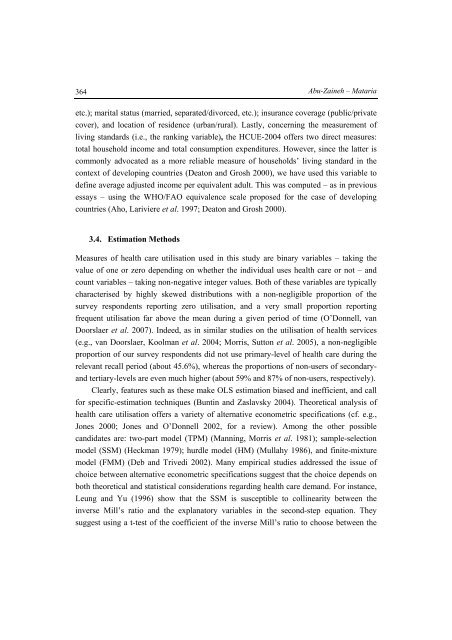The Palestinian Economy. Theoretical and Practical Challenges
The Palestinian Economy. Theoretical and Practical Challenges
The Palestinian Economy. Theoretical and Practical Challenges
You also want an ePaper? Increase the reach of your titles
YUMPU automatically turns print PDFs into web optimized ePapers that Google loves.
364<br />
Abu-Zaineh – Mataria<br />
etc.); marital status (married, separated/divorced, etc.); insurance coverage (public/private<br />
cover), <strong>and</strong> location of residence (urban/rural). Lastly, concerning the measurement of<br />
living st<strong>and</strong>ards (i.e., the ranking variable), the HCUE-2004 offers two direct measures:<br />
total household income <strong>and</strong> total consumption expenditures. However, since the latter is<br />
commonly advocated as a more reliable measure of households’ living st<strong>and</strong>ard in the<br />
context of developing countries (Deaton <strong>and</strong> Grosh 2000), we have used this variable to<br />
define average adjusted income per equivalent adult. This was computed – as in previous<br />
essays – using the WHO/FAO equivalence scale proposed for the case of developing<br />
countries (Aho, Lariviere et al. 1997; Deaton <strong>and</strong> Grosh 2000).<br />
3.4. Estimation Methods<br />
Measures of health care utilisation used in this study are binary variables – taking the<br />
value of one or zero depending on whether the individual uses health care or not – <strong>and</strong><br />
count variables – taking non-negative integer values. Both of these variables are typically<br />
characterised by highly skewed distributions with a non-negligible proportion of the<br />
survey respondents reporting zero utilisation, <strong>and</strong> a very small proportion reporting<br />
frequent utilisation far above the mean during a given period of time (O’Donnell, van<br />
Doorslaer et al. 2007). Indeed, as in similar studies on the utilisation of health services<br />
(e.g., van Doorslaer, Koolman et al. 2004; Morris, Sutton et al. 2005), a non-negligible<br />
proportion of our survey respondents did not use primary-level of health care during the<br />
relevant recall period (about 45.6%), whereas the proportions of non-users of secondary<strong>and</strong><br />
tertiary-levels are even much higher (about 59% <strong>and</strong> 87% of non-users, respectively).<br />
Clearly, features such as these make OLS estimation biased <strong>and</strong> inefficient, <strong>and</strong> call<br />
for specific-estimation techniques (Buntin <strong>and</strong> Zaslavsky 2004). <strong>The</strong>oretical analysis of<br />
health care utilisation offers a variety of alternative econometric specifications (cf. e.g.,<br />
Jones 2000; Jones <strong>and</strong> O’Donnell 2002, for a review). Among the other possible<br />
c<strong>and</strong>idates are: two-part model (TPM) (Manning, Morris et al. 1981); sample-selection<br />
model (SSM) (Heckman 1979); hurdle model (HM) (Mullahy 1986), <strong>and</strong> finite-mixture<br />
model (FMM) (Deb <strong>and</strong> Trivedi 2002). Many empirical studies addressed the issue of<br />
choice between alternative econometric specifications suggest that the choice depends on<br />
both theoretical <strong>and</strong> statistical considerations regarding health care dem<strong>and</strong>. For instance,<br />
Leung <strong>and</strong> Yu (1996) show that the SSM is susceptible to collinearity between the<br />
inverse Mill’s ratio <strong>and</strong> the explanatory variables in the second-step equation. <strong>The</strong>y<br />
suggest using a t-test of the coefficient of the inverse Mill’s ratio to choose between the
















